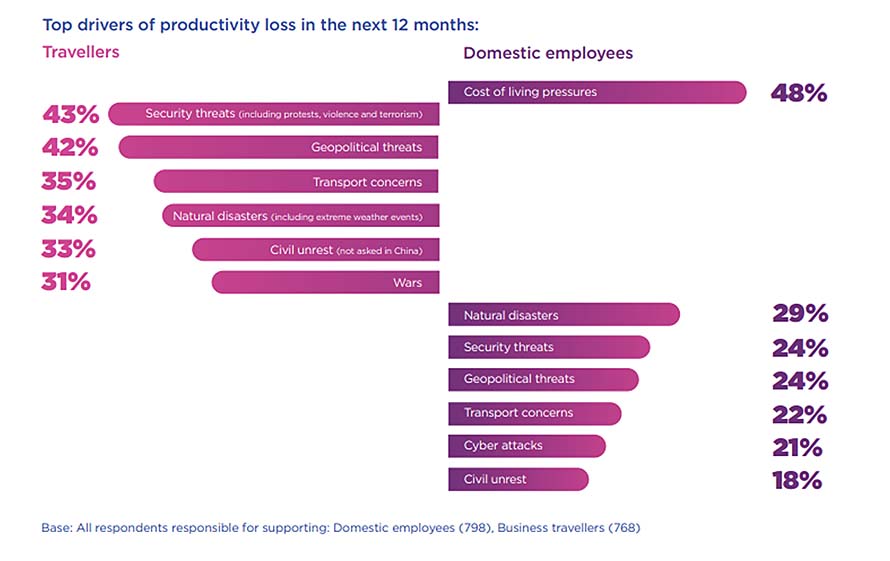
As the acute impacts of the pandemic subside in many countries, organizations worldwide are still set to encounter significant risks in 2023. Experts predict that global risks have the potential to decrease productivity levels, as the cost-of-living crisis and difficult security situation affect employees. That’s according to findings of the International SOS Risk Outlook 2023 report and updated global risk map, which utilise data on the medical and security environment of countries around the world with rankings from “Insignificant” to “Extreme” levels of risk.
Many of the findings from the report are based on a survey of 1,218 senior risk professionals across 108 countries. This provides a detailed view of some of the major risks which organizations must address in 2023. Alongside perennial concerns, such as mental health issues, International SOS is highlighting how organizational leaders should support employees by utilising accurate sources of information as they are impacted by the ever-shifting ‘perma-crisis’ events.
THE INTERNATIONAL SOS VIEW
Five predictions for 2023
Drawing on the findings of the Risk Outlook 2023 survey, the Workforce Resilience Council and the organization’s proprietary data, International SOS’ top five trends organizations need to be aware of in 2023 are:
- Timely, accurate, trusted, actionable: the power of intelligence in decision making
- Adjusting to ‘perma-crisis’: geopolitical shifts, socio-economic challenges and increasing polarisation
- Plan for the unplannable: travellers want more support
- Climate change and other forces are increasing health risks with wide ranging impacts. A comprehensive approach to Health Security is required
- The happy at work equation (A+B+C)-D. A new era for mental health at work.
Accounting for the Impact of Geopolitical Shifts
The Russia/Ukraine conflict was the defining security issue of 2022, highlighting how geopolitics and the threat of interstate conflict are back on the corporate risk agenda. The conflict will certainly still have an impact in 2023, so it is beneficial for organizations to learn how to effectively handle the shifting global risk environment. Geopolitical volatility will also spread beyond Russia/Ukraine in the next 12 months, as increasing fissures between Russia and the West will impact other conflicts and exacerbate longstanding geopolitical tensions. Beyond the highly visible Russia/West divide, US-China competition will increasingly dominate the geopolitical and economic landscape. Best practice for organizations is to consistently revisit the likelihood and possible impact to understand potential implications for their business and people.
Many crisis management teams are learning to deal with a state of ‘perma-crisis’. It will be beneficial for organizations in 2023 to provide the correct level of training, investment, and support for these teams, as experts have drawn attention to significantly high levels of crisis management fatigue. Managing crisis management fatigue is key in moving from ‘perma-crisis’ to crisis resilience and organizations who effectively embedded learnings from the last two years will emerge with more robust capabilities to manage challenges.
This is going to be a major issue, as many surveyed experts predict that these geopolitical trends will negatively impact productivity levels in the next year:

Rising Levels of Social Unrest
The findings highlighted here also demonstrate how many experts predict that social unrest will additionally be a key driver of lost productivity in 2023. For instance, 48% predict that cost of living pressures will impact domestic employees and 33% see civil unrest impacting business travellers.
Social unrest is clearly going to be a major item on the C-suite agenda in 2023, as the problem is truly multifaceted, affecting organizations and employees in a number of ways. Some themes and key points for 2023 include:
- Volatility in energy and agricultural markets will fuel unrest, particularly in unstable, fragile economies. Most likely locations: Sub-Saharan Africa, Egypt, Lebanon
- Lack of progress on resolving underlying economic or political issues will provoke growing public dissatisfaction and cycles of unrest where the risk of violence grows over time. Most likely locations: Pakistan, Sri Lanka, Ecuador, Peru, Iraq
- Polarisation at a global level will be reflected in further domestic polarisation inflaming pre-existing triggers for social unrest and, in extremis, influencing more localized violence and criminal activity. High risk locations: US, Western Europe
Sally Llewellyn, Global Security Director, International SOS, comments “The drivers for unrest will be numerous in 2023 and accounting for the impact of social unrest is going to be a key task for businesses in 2023. Mitigation starts with understanding the risk environments in which organizations operate, drivers of unrest and most likely impacts on employees and operations. This can also help businesses to ensure they have the right early warning systems in place, understand the potential triggers and what kind of organizational response is needed to counter any security issues. Education is also key. Employees and decision makers need to be knowledgeable about risks and steps their organization is taking to mitigate them to keep the workforce safe.”
The Growing Impact of Climate Change
In 2023 the impact of climate change needs to be considered at multiple levels, beyond the immediate effects of extreme weather events. It is foreseeable that health risks associated with climate change may increase. Experts advise that climate change is contributing to an acceleration in emergence of new and re-emerging of old infectious diseases, illustrated by the multiple “unusual” outbreaks of the 21st century, including SARS, Ebola, COVID-19 and Mpox. A briefing published in Nature Climate Change in August 2022 estimates “Over half of known human pathogenic diseases can be aggravated by climate change”.
Climate change is expected to increase mosquito-borne diseases as temperatures and standing water levels increase. This situation could potentially cause outbreaks of Malaria, Dengue Fever and Zika in places where they have never been present before, and more frequent outbreaks in areas where they already exist.
This all comes when only 25% of respondents said their organization is actively planning for future pandemics and COVID-19 variants. Best practice includes undertaking risk assessments of existing and potential health threats and incorporating forecasts for potential geographic extension of hazards due to climate change and other forces.
Dr Irene Lai, Medical Director at International SOS comments “Organizations are well-versed in how to respond to the ongoing COVID-19 pandemic. However, they should build on this existing knowledge and broaden crises and business continuity plans to include known health risks as well as potential health threats. It can be useful to run exercises encompassing likely, as well as unlikely worst-case scenarios to ensure teams are prepared. Forward planning to ensure organizational resilience is critical as climate change is contributing to multiple crises occurring simultaneously, and another pandemic is inevitable”.
Travellers Set For Much Needed Support in 2023
The Risk Outlook research report also highlights that most organizations (86%) are keeping travel risk management budgets the same or increasing, so it is likely that travel will continue to grow and return to pre-pandemic levels.
This is a trend well supported by the International SOS case data, our traveller tracking data, which shows international travel now at 83% of pre-COVID volumes, but travellers are twice as likely to call for advice or assistance.
Business travel is clearly going to be complex in 2023 and mitigation of many issues is important. It is, however, encouraging that despite rising costs, experts predict that travel management budgets will increase or stay the same in 2023. This kind of investment will be key to keep business travellers safe in the year ahead.
![]()







